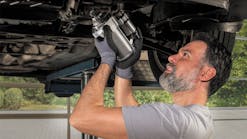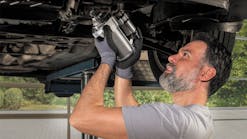While you may think of exhaust gas readings as being important only for I/M programs, this critical information also applies to diagnosing general performance problems. Unfortunately, too many technicians learn about exhaust gas analysis only when something’s wrong, rather than when things are operating normally.
COMBUSTION THEORY
Unfortunately, combustion is often misunderstood because many think that a cylinder fires or it doesn't — end of story. Realistically, combustion goes way beyond the "fire or no fire" theory, with all sorts of variables affecting the way an air-fuel mixture burns inside a cylinder. To keep things in lucid and relative terms, however, we'll focus on combustion from the standpoint that it affects you as a service technician instead of as an engineer.
In order for combustion to occur, fuel, air and pressure (compression) must be present inside the cylinder. If any of the three elements are missing, combustion simply won't occur.
When a spark plug fires, the secondary voltage bridging the spark plug gap ionizes a small portion of the air-fuel mixture present between the electrodes. Once the molecules in that area ignite, a flame front begins to move out to the rest of the combustion chamber, traveling in a rapid, yet controlled, progression. Referred to as flame propagation, it's the gradual burning, or combustion, of the air-fuel mixture. As the flame front continues to move across the combustion chamber, there are fewer and fewer molecules of the air-fuel mixture left. Eventually, there will be too few to support combustion, and the flame front will extinguish.
The most critical aspect to remember about combustion is that when it occurs normally, it happens in phases; it is not an explosion.
THE BIG THREE
If combustion were perfect, all of the fuel and air within the combustion chamber would be consumed, leaving only water, carbon dioxide and heat energy. This would leave no harmful emissions, making emission control systems, and I/M programs for that matter, completely unnecessary.
In the real world, an engine never achieves complete combustion regardless of the engine's age or add-on equipment. As a result, three harmful by-products of combustion result, called emissions, each one proven to be an environmental and health hazard.
For states running I/M programs that use exhaust gas levels as the pass/fail cutpoint, each of these compounds are considered to determine vehicle emissions.
• Hydrocarbons (HC) — Made of carbon and hydrogen atoms, HCs exist in several different forms, each having the nasty reputation of being major contributors to photochemical smog. Since HCs are always present in the exhaust when combustion isn't complete, you'll always find some HCs present when testing. High HC levels are often related to engine misfire. In general terms, you can think of HC readings as the level of unburned fuel. Typical causes of high HC readings include a misfiring spark plug, bad ignition wire or a bad port injector spray pattern.
• Carbon monoxide (CO) — Another by-product of incomplete combustion, CO molecules are made of carbon and oxygen. CO ranks as an undesirable because of its innocent personality, but deadly behavior when inhaled. Generally, you can think of CO readings as the level of burned fuel. Common causes of high CO readings include rich mixtures related to high fuel pressure and leaking injectors.
• Oxides of nitrogen (NOx) — Consisting of nitrogen in combination with varying amounts of oxygen, NOx is the result of heat and pressure in the combustion chamber. Like HC, NOx is another contributor to the formation of photochemical smog. High NOx readings usually result from a faulty EGR system and excessive combustion-chamber deposits.
COMBUSTION/EXHAUST GAS RELATIONSHIPs
Many variables and subsystems will determine the actual emissions from a car's tailpipe, but it's important that you gain an understanding on how various aspects of the combustion cycle can affect gas levels at the tailpipe. Of course, remember that the vehicle’s catalytic converter has a neutralizing effect on gas readings during testing.
A rich air-fuel mixture will increase CO readings, but may not increase HC readings significantly unless the engine misfires from the rich condition. Also, because of the cooling effect of the rich mixture, NOx levels are likely to be lower than when the mixture is closer to stoichiometric (14.7:1).
A lean air-fuel mixture will cause lower CO readings, but HC levels may rise dramatically if the engine misfires as a result. In addition, since lean mixtures tend to cause combustion chamber temperatures to soar, NOx levels will increase.
Ignition timing advanced beyond its normal range results in higher NOx and HC levels due to the increased combustion chamber temperature. CO, on the other hand, may stay the same or increase depending on the amount of timing advance.
Conversely, ignition timing retarded beyond its normal range increases CO because combustion is likely to still occur once the exhaust valve opens. Since cylinder pressures and temperatures are reduced at this time, HC and NOx emissions drop.
A neglected cooling system can cause NOx readings to increase, while having only a slight impact on HC and CO levels. Deposits around combustion chambers can result in hot spots, causing combustion chamber temperatures to skyrocket.
A weak ignition coil can't sustain the proper spark duration to continue igniting air-fuel molecules. When this happens, HC readings increase, CO readings may drop slightly and NOx readings will drop.
Interpreting exhaust gas readings goes beyond “poke and hope” methods. With a thorough understanding of what triggers each gas when it’s formed, you’ll be better prepared to deal with the root cause of combustion-related problems.


